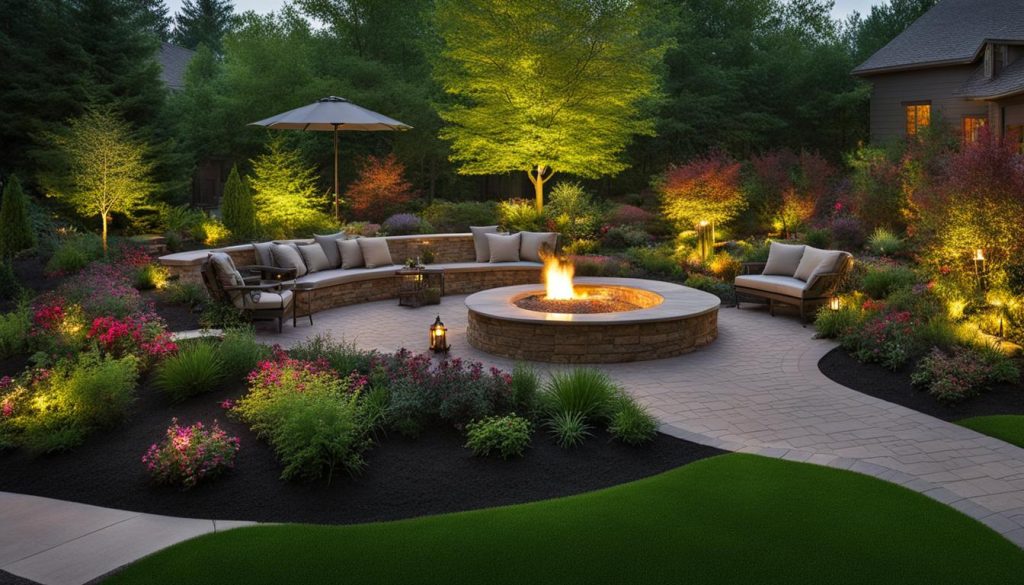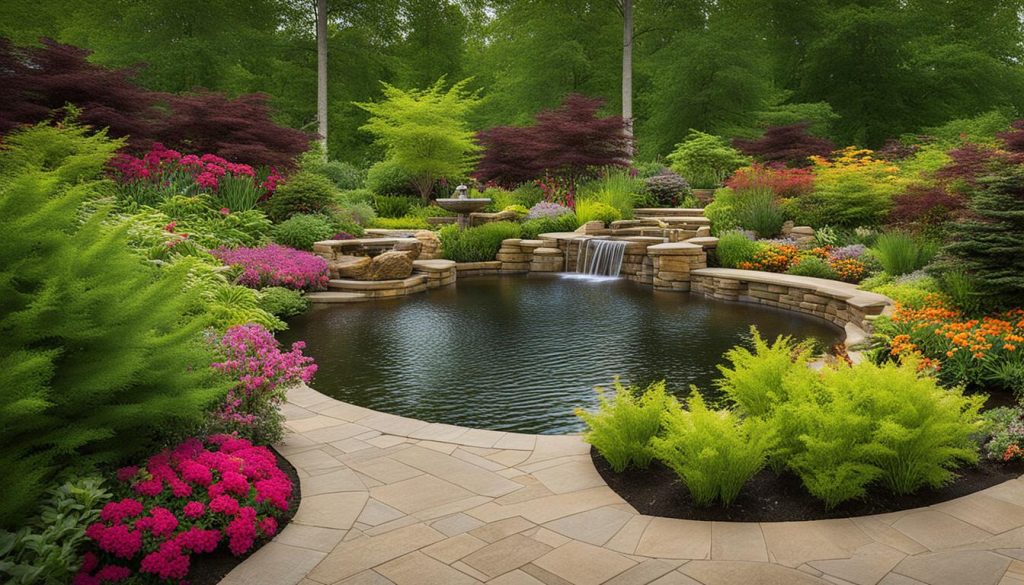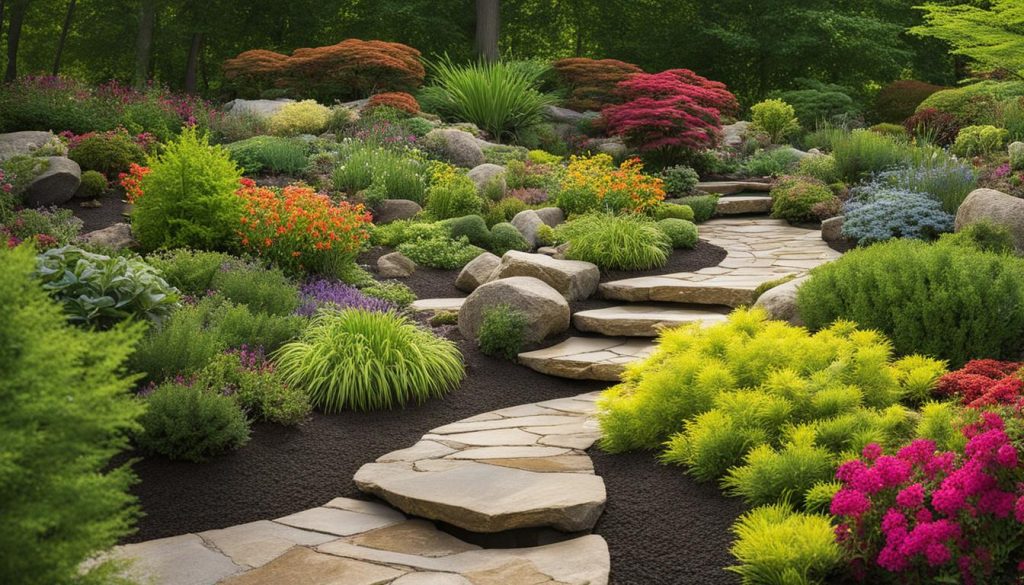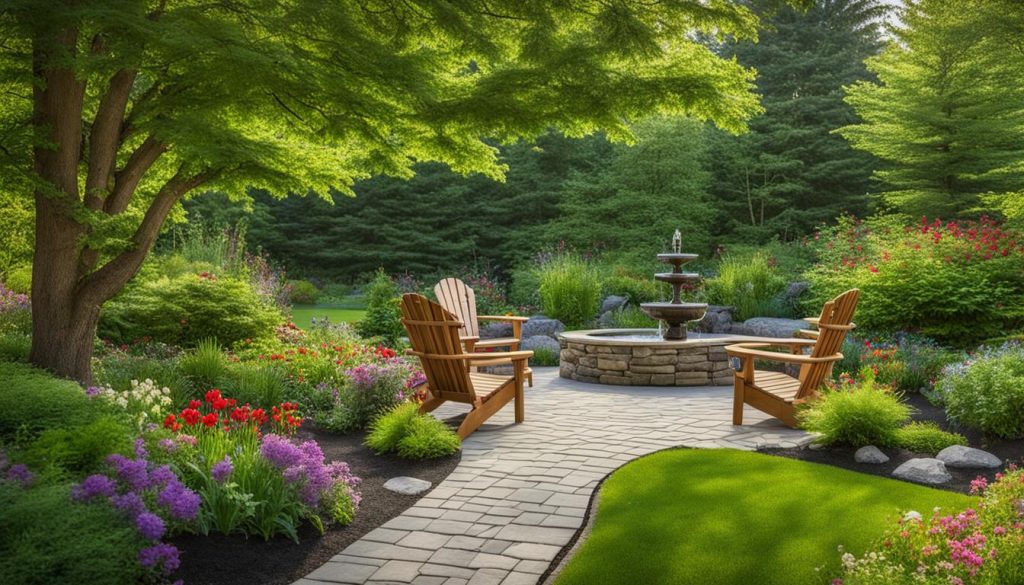Welcome to our expert guide on planning and designing a stunning garden landscape for your outdoor space, be it a cozy backyard or a vast Canadian garden. With our tips and guidance, you can create a captivating backyard that nurtures nature and brings joy to your home.
Designing a garden landscape is not just about aesthetics; it’s about creating a space that meets your needs and fits your lifestyle. Whether you want a peaceful retreat or a vibrant entertainment area, our guide will help you achieve your goals.
Let’s explore the essential steps in garden landscape design, from understanding your space and needs to selecting the right plants and materials and enhancing with lighting and accessories. Get ready to transform your outdoor space into a paradise with our expert guidance.
Understanding Your Space and Needs
Before diving into the world of garden landscape design, it’s important to understand the unique needs of your outdoor space. At our company, we believe that any successful design starts with a clear understanding of the area and the homeowner’s needs.
Begin by assessing the size and shape of your outdoor space. Consider any existing features, such as trees, patios, or decks. Take measurements and create a rough sketch of the area to help visualize your design.
Next, think about your needs and preferences. Do you want a low-maintenance garden you can enjoy year-round, or are you willing to put in the effort to create a more intricate design? Do you want to prioritize functionality, such as a space for entertaining or growing your own food, over aesthetic appeal? Understanding these factors will help you create a design that is tailored to your lifestyle and goals.

Once you have a solid understanding of your space and needs, it’s time to move on to designing the layout. Keep reading to learn more about this essential step in creating a beautiful Canadian backyard.
Designing the Layout
Now that we have a clear idea of our outdoor space and needs, it’s time to start designing the layout. A well-designed layout can elevate the aesthetic appeal of your garden landscape and make it functional for your daily activities.
Start by sketching a rough plan of your garden area, including any existing features like trees or retaining walls. This will give you a better sense of the size and shape of your outdoor space.

Next, consider the placement of various design elements, such as pathways, flower beds, seating areas, and focal points. Be mindful of the flow of traffic and how it affects the usability of your garden landscape.
When designing the layout, it’s important to follow some basic design principles, such as balance, rhythm, and focalization. Achieving balance can involve evenly distributing visual weight, while rhythm can be created by repeating patterns or shapes in your design. Focalization involves creating a point of visual interest or emphasis within your garden landscape.
Another consideration is the use of negative space, which refers to the empty space between design elements. Negative space is essential for creating a sense of harmony and balance in your garden landscape design.
Remember to be flexible and open to changes as you design your garden landscape layout. It’s normal to make adjustments and tweaks along the way as you see how different elements interact with each other.
Selecting Plants and Materials
When it comes to selecting plants and materials for your garden landscape design, it’s crucial to choose wisely. Your choices will not only affect the aesthetic appeal of your outdoor space but also its sustainability and maintenance requirements.
Choosing the Right Plants
The Canadian climate can be quite challenging for plants, with dramatic temperature fluctuations, harsh winters, and limited growing seasons. Therefore, it’s vital to select plants that can thrive in your particular region and microclimate.
Consider the amount of sunlight, moisture, and wind your garden receives, as well as the soil type and pH level. An excellent way to ensure success is to opt for native plants that have evolved to thrive in your local environment. These plants will require less watering, fertilizer, and maintenance, while also providing food and habitat for local wildlife.
Additionally, it’s essential to choose plants that complement each other and create a balanced and harmonious color palette. Consider using the color wheel to find colors that are opposite each other or adjacent to each other for a more cohesive look.

Selecting Durable and Sustainable Materials
The selection of materials for hardscaping features, such as paths, walls, and patios, is essential for both aesthetic and practical reasons.
Choose materials that are durable, weather-resistant, and require minimal maintenance, such as stone, brick, or concrete. These materials are also long-lasting and eco-friendly, reducing the need for frequent replacements.
If you prefer to use wood, opt for sustainably harvested or recycled options that are resistant to rot, pests, and decay. Cedar, redwood, and tropical hardwoods are good choices for their natural beauty and durability.
Remember to choose materials that complement the overall design and style of your garden landscape. Consider using different textures, colors, and patterns to create visual interest and contrast.
Creating a Balanced and Cohesive Design
When selecting plants and materials, it’s crucial to keep the overall design and style in mind. A well-designed garden landscape should have a balanced and harmonious look that connects different elements seamlessly.
Consider using repetition, rhythm, and symmetry to create a sense of unity and coherence. Repeat certain plants or materials in different areas of your garden to create a cohesive flow. Use curves and pathways to create movement and flow, while also providing access and circulation.
In summary, selecting the right plants and materials is a crucial aspect of garden landscape design. Choose plants that can thrive in your local climate, complement each other, and create a balanced color palette. Opt for durable and sustainable materials that require minimal maintenance and complement the overall design and style of your outdoor space.
Enhancing with Lighting and Accessories
Lighting and accessories are the finishing touches that can take your garden landscape to the next level. Let’s explore some ideas on how to enhance the beauty and functionality of your Canadian backyard with these elements.
Lighting Techniques
Outdoor lighting not only provides safety and security but also creates a warm and inviting ambiance. Here are some lighting techniques to consider:
- Pathway Lighting: Illuminate your walkways with small, low-level lights that guide your steps and add a magical feel.
- Spotlighting: Use spotlights to draw attention to trees, statues, and other focal points in your garden landscape.
- Up-lighting: Place lights on the ground and angle them upwards to highlight trees or other vertical elements.
- String Lights: Add a cozy and playful touch by hanging string lights along your patio or pergola.
Accessories
Accessories can add personality and character to your garden landscape. Here are some examples of how to incorporate them:
- Seating: Choose comfortable and stylish outdoor furniture to create comfortable seating areas where you can relax and enjoy your garden landscape.
- Water Features: Add the soothing sound of water to your garden landscape with a fountain, pond, or waterfall.
- Statues and Sculptures: Use statues and sculptures to add a touch of art and whimsy to your garden landscape. Choose pieces that complement the style and theme of your outdoor space.
- Garden Art: Hang colorful and interesting pieces of garden art, like wind chimes or stained glass, to create a vibrant and dynamic landscape.
We hope these ideas have inspired you to enhance your garden landscape with lighting and accessories. Remember to choose elements that reflect your personality and style, and have fun creating a beautiful Canadian backyard!
FAQ
How do I start planning and designing my garden landscape?
To start planning and designing your garden landscape, it’s important to first understand your space and needs. Assess the size, shape, and existing elements of your outdoor area. Consider your preferences, goals, and lifestyle. This will help you create a design that is tailored to your specific needs.
What should I consider when designing the layout of my garden landscape?
When designing the layout of your garden landscape, it’s important to consider various elements such as pathways, flower beds, seating areas, and focal points. Sketch and plan the placement of these elements to create a harmonious and visually appealing layout. Explore different design principles and techniques to help you achieve your desired result.
How do I select the right plants and materials for my garden landscape?
Selecting the right plants and materials for your garden landscape is crucial. Consider plants that thrive in the Canadian climate and select durable and sustainable materials for hardscape features. Creating a balanced and cohesive design involves considering factors such as color, texture, and growth patterns. Take your time to research and choose wisely.
What can I do to enhance my garden landscape with lighting and accessories?
Lighting and accessories can significantly enhance the beauty and functionality of your garden landscape. Explore different lighting techniques to create ambiance and extend your outdoor enjoyment into the evening. You can also consider adding various accessories such as furniture, sculptures, and water features to add character and charm to your Canadian backyard.

